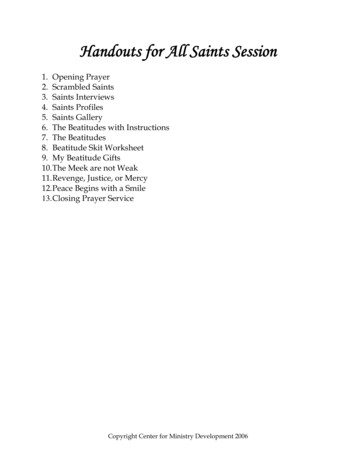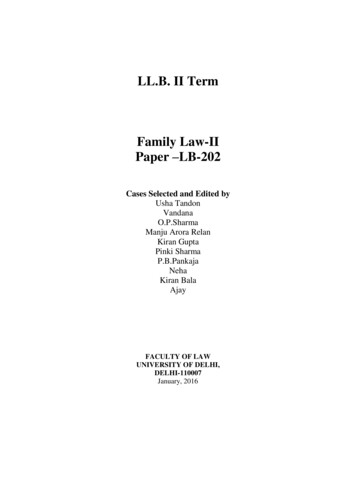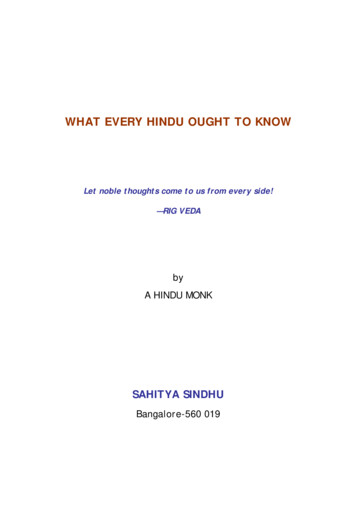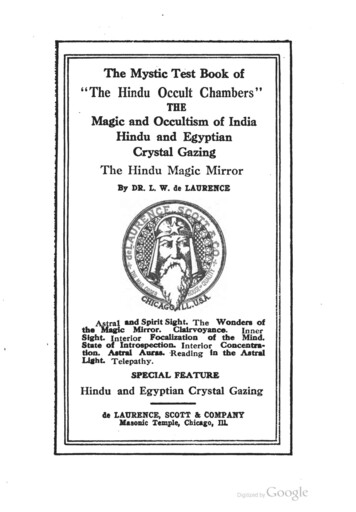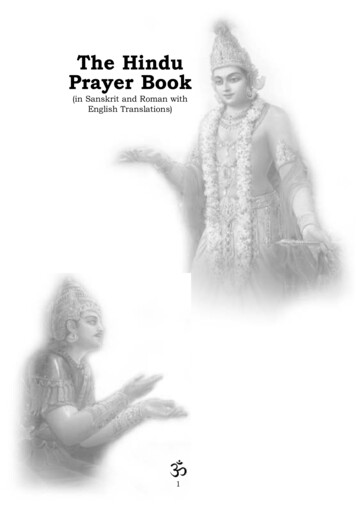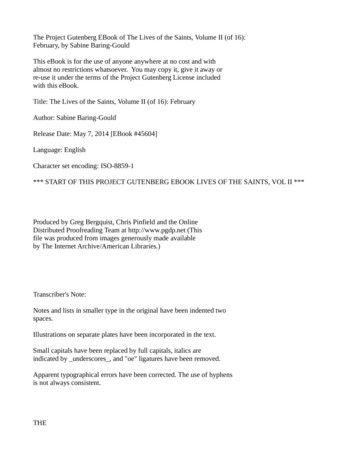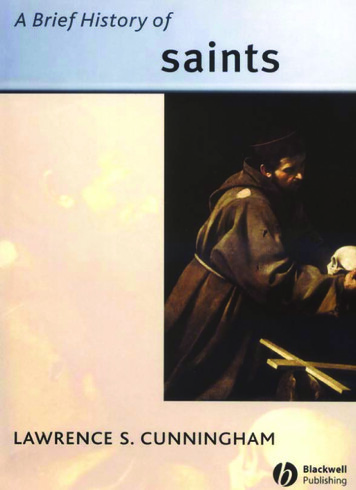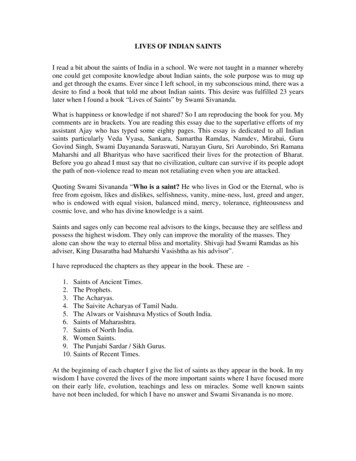
Transcription
LIVES OF INDIAN SAINTSI read a bit about the saints of India in a school. We were not taught in a manner wherebyone could get composite knowledge about Indian saints, the sole purpose was to mug upand get through the exams. Ever since I left school, in my subconscious mind, there was adesire to find a book that told me about Indian saints. This desire was fulfilled 23 yearslater when I found a book “Lives of Saints” by Swami Sivananda.What is happiness or knowledge if not shared? So I am reproducing the book for you. Mycomments are in brackets. You are reading this essay due to the superlative efforts of myassistant Ajay who has typed some eighty pages. This essay is dedicated to all Indiansaints particularly Veda Vyasa, Sankara, Samartha Ramdas, Namdev, Mirabai, GuruGovind Singh, Swami Dayananda Saraswati, Narayan Guru, Sri Aurobindo, Sri RamanaMaharshi and all Bharityas who have sacrificed their lives for the protection of Bharat.Before you go ahead I must say that no civilization, culture can survive if its people adoptthe path of non-violence read to mean not retaliating even when you are attacked.Quoting Swami Sivananda “Who is a saint? He who lives in God or the Eternal, who isfree from egoism, likes and dislikes, selfishness, vanity, mine-ness, lust, greed and anger,who is endowed with equal vision, balanced mind, mercy, tolerance, righteousness andcosmic love, and who has divine knowledge is a saint.Saints and sages only can become real advisors to the kings, because they are selfless andpossess the highest wisdom. They only can improve the morality of the masses. Theyalone can show the way to eternal bliss and mortality. Shivaji had Swami Ramdas as hisadviser, King Dasaratha had Maharshi Vasishtha as his advisor”.I have reproduced the chapters as they appear in the book. These are 1. Saints of Ancient Times.2. The Prophets.3. The Acharyas.4. The Saivite Acharyas of Tamil Nadu.5. The Alwars or Vaishnava Mystics of South India.6. Saints of Maharashtra.7. Saints of North India.8. Women Saints.9. The Punjabi Sardar / Sikh Gurus.10. Saints of Recent Times.At the beginning of each chapter I give the list of saints as they appear in the book. In mywisdom I have covered the lives of the more important saints where I have focused moreon their early life, evolution, teachings and less on miracles. Some well known saintshave not been included, for which I have no answer and Swami Sivananda is no more.
Saints of Ancient TimesChapter 1The saints of Ancient Times were Maharshi Vyasa, Sage Yajnavalkya, Yogi Bhusanda,Dattatreya, Yogi Jaigisavya, Thirumula Nayanar.MAHARSHI VYASAIn ancient days, our forefathers, the Rishis of Aryavartha, went to the forest to doTapasya during the four months following Vyasa Purnima – a particular and importantday in the Hindu calendar. On this memorable day, Vyasa, an incarnation of the LordHimself, began to write his Brahma Sutras. Our ancient Rishis did this Tapasya in cavesand forests. But times have changed and such facilities are not common nowadaysalthough Grihasthas and Rajas are wanting who are able and willing to place at thedisposal of the members of the fourth Ashrama such help and facilities as they can afford.The forests and caves have given place to the rooms of Sadhus in their own Gurudwarasand Mutts.One has of necessity to suit himself to time and place; and change of place andsituation should not be allowed to make such a different in our mental attitudes.Chaturmas begins from the Vyasa Purnima Day when, according to our Shastras, we areexpected to worship Vyasa and the Brahmavidya Gurus and begin the study of theBrahma Sutras and other ancient books on ‘wisdom’.Our mythology speaks of many Vyasa; and it is said that there had been twenty-eightVyasas before the present Vyasa-Krishna Dvaipayana-took his birth at the end ofDvapara Yuga. Krishna Dvaipayana was born of Parasara Rishi through theMatsyakanya-Satyavathi Devi - under some peculiar and wonderful circumstances.Parasara was a great Jnani and one of the supreme authorities on astrology and his bookParasara Hora is still a textbook on astrology. He has also written a Smriti known asParasara Smriti which is held in such high esteem that it is quoted by our present-daywriters on sociology and ethics. Parasara came to know that a child, conceived at aparticular Ghatika or moment of time, would be born as the greatest man of the age, nayas an Amsa of Lord Vishnu Himself. On that day, Parasara was travelling in a boat andhe spoke to the boatman about the nearing of that auspicious time. The boatman had adaughter who was of age and awaiting marriage. He was impressed with the sanctity andgreatness of the Rishi and offered his daughter in marriage to Parasara. Our Vyasa wasborn of this union and his birth is said to be due to the blessing of Lord Siva Himself whoblessed the union of a sage with a Jnani of the highest order. Although of a low caste.At a very tender age Vyasa gave out to his parents the secret of his life that he should goto the forest and do Akhanda Tapas. His mother at first did not agree, but later gavepermission on one important condition that he should appear before her whenever shewished for his presence. This itself shows how far-sighted the parents and the son were.Puranas say that Vyasa took initiation at the hands of his twenty-first Guru, sageVasudeva. He studied the Shastras under sages Sanaka and Sanandana and others.He arranged the Vedas for the good of mankind and wrote the Brahma Sutras for thequick and easy understanding of the Srutis; he also wrote the Mahabharata to enable
women, Sudras and other people of lesser intellect to understand the highest knowledgein the easiest way. Vyasa wrote the eighteen Puranas and established the system ofteaching them through Upakhyanas or discourses. In this way, he established the threepaths, viz., Karma, Upasana and Jnana. To him is also attributed the fact that hecontinued the line of his mother and that Dhritarashtra, Pandu and Vidura were hisprogeny. Vyasa’s last work was the Bhagavata which he undertook at the instigation ofDevarshi Narada who once came to him and advised him to write it as, without it, hisgoal in life would not be reached.Vyasa is considered by all Hindus as a Chiranjivi, one who is still living and roamingthroughout the world for the well-being of his devotees. It is said that he appears to thetrue and the faithful and that Jagadguru Sankaracharya had his Darshan in the house ofsage Mandana Misra and that he appeared to many others as well. Thus, in short, Vyasalives for the welfare of the world. Let us pray for his blessings on us all and on the wholeworld.Everybody knows that there are six important systems of thought developed by ourancients known as the Shad Darshanas or the six orthodox schools of philosophy, viz.,Sankhya, Yoga, Nyaya, Vaiseshika, Purva Mimamsa and Uttara Mimamsa or Vedanta.Each system has a different shade of opinion. Later, these thoughts became unwieldy,and to regulate them, the Sutras came into existence, Treatises were written in shortaphorisms, called “Sutras” in Sanskrit, meaning clues for memory or aids to longdiscussions on every topic. In the Padma Purana, the definition of a Sutra is given. It saysthat a Sutra should be concise and unambiguous; but the brevity was carried to such anextent that the Sutra has become unintelligible and particularly so in the Brahma Sutras.Today we find the same Sutra being interpreted in a dozen ways. The Brahma Sutraswritten by Vyasa or Badarayana for that was the name which he possessed in addition arealso known as Vedanta Sutras as they deal with Vedanta only. They are divided into fourchapters, each chapter being subdivided again into four sections. It is interesting to notethat they begin and end with Sutras which read together mean “the inquiry into the realnature of Brahman has no return “, meaning that “going by that way one reachesImmortality and no more returns to the world”’ About the authorship of these Sutras,tradition attributes it to Vyasa. Sankarachatya, in his Bhashya, refers to Vyasa as theauthor of the Gita and the Mahabharata, and to Badarayana as the author of the BrahmaSutras. His followers-Vachaspathi, Anandagiri and others identify the two as one thesame person, while Ramanuja and others attribute the authorship of all three to Vyasahimself. The oldest commentary on the Brahma Sutras is by Sankaracharya; he was laterfollowed by Ramanuja, Vallabha, Nimbarka, Madhva and others who established theirown schools of thought. All the five Acharyas mostly agree on two points, viz., (i) thatBrahman is the cause of this world and (ii) that knowledge of Brahman leads to finalemancipation. But they differ amongst themselves on the nature of this Brahman, therelation between the individual soul and the Supreme Soul, and the condition of the soulin the state of release. According to some, Bhakti and not Jnana, as interpreted bySankara, is the chief means of attaining liberation.
Vyasa’s life is a unique example of one born for the dissemination of spiritualknowledge. His writings inspire us and the whole world even to this day. May we all livein the spirit of his writings !(For all those who believe that upper and lower caste had this Chinese wall between themplease note that Vyasa’s mother was of low caste. Vyasa would be remembered forarranging the Vedas and writing the Holy Geeta. When ever I am confused or feeling lowI go the best friend ie the Geeta. I go to any page, after an hour reading I feel better with aclear mind. A friend tells me that everytime she reads the Geeta she learns somethingnew, comes out with a different interpretation).SAGE YAJNAVALKYAThe name of Yajnavalkya of Mithila stands distinguished both in the Srutis and inthe Smritis. Yajnavalkya is especially known for his unsurpassed spiritual wisdom andpower. The seer of a Veda Samhita from Bhagavan Surya, the revealer of Brahma Jnanato Janaka, Maitrey! And other, Yajnavalkya hails supreme among sages of sacredmemory. As to his obtaining the Shukla Yajurveda Samhita from Bhagavan Surya, thereis the following history.Yajnavalkya was the son of the sister of Mahamuni Vaishampayana, theVedacharya of the Taittiriya section. He was studying the Taittiriya Samhita fromVaishampayana who was also his Guru. Vaishampayana had many other disciples tooand they all were students of the Taittiriya Shakha.Once all the Rishis decided to form an association near the Meru mountain andmade a rule that any Rishi who absented himself at the appointed hour should incur thesin of Brahmahatya (the sin of killing a Brahmin) for seven days. On that appointed dayfell the Sraddha ceremony of Vaishampayana’s father. Vaishampayana thought,“Somehow I have to perform my father’s ceremony. If the sin of Brahmahatya comes tome, my disciples will observe the expiatory penance therefor”. So Vaishampayana didnot attend the meeting of the Rishis. And accordingly he incurred the sin of Brahmahatya.Then Vaishampayana said to his disciples, “Now I have to expiate this great sin ofBrahmahatya. Therefore, you all will observe, for my sake, an expiatory penance forseven days”.At once Yajnavalkya stood up and said, “O Guru! All these are poor-spiritedyoung students. They will not be able to undergo such a hard penance. So, instead of all, Imyself alone shall observe it in the manner in which nobody else can”. Vaishampayanatold Yajnavalkya not to undertake it alone. But Yajnavalkya persisted. The preceptor wasoffended at this audacious attitude of the disciple and said, “O proud one, you are veryconceited. You get away from me. Enough of you who is disposed to despise wiseBrahmins. Give back to me immediately whatever you have learnt from me”.
Upon the order of the Guru, Yajnavalkya, the son of Devarata, vomited out thecollection of the Yajus in the form of food. The other disciples ate that food taking theform of the Tittiri birds, because they were very eager to receive the same. They then hadthe direct revelation of those Yajurveda collections. As the Tittiri birds ate this Veda, it isthenceforth called the Taittiriya Yajurveda. It is also known as Krishna (black) Yajurvedaon account of its being vomited substance.Then Yajnavalkya determined not to have any human Guru thereafter. Thus hebegan to propitiate the Sun-God, Surya. Yajnavalkya worshipped and extolled the Sun,the master of the Vedas, for the purpose of acquiring the fresh Vedic portions not knownto his preceptor, Vaishampayana.Yajnavalkya said, “Prostration to the glorious Aditya, who in the form of theAtman, abides in all beings. I bow to Him who surrounds all like Akasa, who is one andnot separated or distanced by limiting conditions. O Great God, O Creator, I contemplateupon that glowing sphere which lights and warms the whole worlds ! O God who burnsall miseries wrought by unrighteous activities, who burns ignorance, which is the seed ofactivity! O Lord, I worship Thy lotus-like feet praised and worshipped by the rules of thethree worlds. Give me those portions of the Veda which are not known to others”.The Sun-God, the glorious Lord Hari, pleased with Yajnavalkya’s penance,assumed the from of a house and taught the sage such fresh portions of the Yajurveda aswere not known to any other. This portion of the Yajurveda goes by the name of ShuklaYajurveda. It is also known as Vajasaneya Yajurveda, because it was evolved in greatrapidity by Surya in the form of a horse through his manes. Yajnavalkya divided thisVajasaneya Yajurveda again into fifteen branches, each branch comprising hundreds ofYajus Mantras. Kanva, Madhyandina and others learnt those branches.Yajnavalkya married two wives. One was Maitreyi and the other Katyayani. Ofthe two, Maitreyi was a Brahmavadini. When Yajnavalkya wished to divide his propertybetween the two wives before starting for the fourth Ashrama of his life, Maitreyi askedwhether she could become immortal through wealth. Yajnavalkya replied that there wasno hope of immortality through wealth and that she would only become one among themany who were well todo on earth. On hearing this, Maitreyi requested Yajnavalkya toteach her what he considered as the best. Then Yajnavalkya elaborately described to herthe sole greatness of the Absolute Self, the nature of Its existence, the way of attaininginfinite knowledge and immortality etc. This immortal conversation betweenYajnavalkya and Maitreyi is recorded in the Brihadaranyaka Upanishad. Thecentral theme of the discourse is this: “All things are dear, not for their sake, but for thesake of the Self. This Self alone exists everywhere. It cannot be understood or known, forIt alone is the Under stander and the Knower. Its nature cannot be said to be positively assuch. It is realized through endless denials as ‘not this, not this’. The Self is selfluminous, indestructible, unthinkable”.
The other wife Katyayani the daughter of Bharadhwaja, was of commonintelligence, and through her Yajnavalkya had three sons Chandrakanta, Mahamegha andVijaya.Yajnavalkya, though a great Brahmajnani, was a great Karmakandi too. Hecaused many Yajnas to be performed and himself became the Acharya of those greatYajnas. He was a celebrated Srotriya and a Brahma-nishtha Guru. Once King Janaka ofVideha wanted to know from which real Brahmanishtha to receive Brahma Vidya. Inorder to find out who was the real Brahma-nishtha, Janaka performed a hugeBahudakshina sacrifice to which all the Rishis from far and wide were invited. And heoffered one thousand cows with their calves, all their horns beings decked with enormousgold. Then he proclaimed to the assembled ones, “Whosoever is the best Brahmanaamongst you may drive these cows home”. None dared to get up and take away the cowsas they were afraid of censure by the others. But Yajnavalkya stood up and asked hisdisciple Samasravas to drive the cows home.The other Brahmanas got angry and said to one another, How can he declarehimself to be the best among us? Thereupon several Rishis challenged Yajnavalkya withmany questions on transcendental matters to all of which Yajnavalkya gave prompt reply.There was a great debate in which Yajnavalkya won over all the others. Janaka wasconvinced that Yajnavalkya was the best Brahma-nishtha and received Brahma Vidyafrom him thereafter.The third and the fourth chapters of the Brihadaranyaka Upanishad abound withthe great philosophical teachings of Yajnavalkya. Yajnavalkya was also the author of thefamous Yajnavalkya Smriti. His other works are Yajnavalkya Shakha, Pratijna Sutra,Satapatha Brahmana, and Yoga-Yajnavalkya.At the sacrifice of Janaka, there was an exchange of words between Yajnavalkyaand Vaishampayana. But on hearing that Yajnavalkya had obtained a fresh Veda from theSun-God, Vaishampayana was much pleased and he requested Yajnavalkya to teach thatVeda to his own disciples also. Yajnavalkya consented and taught his Veda to thedisciples of Vaishampayana. In the end, Yajnavalkya took Vidvat Sannyasa and retiredto the forest.Yajnavalkya was one of the greatest sages ever known. We find him arguing withand overcoming even his teacher Uddalaka at the court of Janaka. His precepts ascontained in the Upanishads stand foremost as the crest-jewel of the highest teachings onBrahma Vidya.DATTATREYAAnasuya is generally quoted as the model of chastity. She was the wife of AtriMaharishi, a great sage and one of the sapta Rishis. She was well established in PativrataDharma. She served her husband with intense devotion. She did severe Tapas for a verylong time in order to beget sons equal to Brahma, Vishnu and Siva.
Once Narada took a small ball of iron-the size of a gram-grain-to Sarasvati andsaid to her, “O Sarasvati Devi! Please fry this iron ball. I will take this iron-ball-gramduring my travel”. Sarasvati laughed and said, “ O Rishi Narada! How can this iron ballbe fried? How can this be eaten?” Narada afterwards went to Mahalakshmi and Parvatiand requested them to fry the iron ball. They also laughed at Narada Rishi Then Naradasaid, “O Devis! See, I will get it fried by Anasuya, wife of Atri Maharishi, a greatPativrata who lives in the earth-plane”.Then Narada came to Anasuya and requested her to fry the iron-ball-gram.Anasuya put the iron ball in the frying pan, meditated on the form of her husband and puta few drops of water which were used in washing the feet of her husband on the iron ball.The iron ball was at once fried. Narada went to Sarasvati, Lakshmi and Parvati, ate beforethem the fried iron ball-gram and gave them also a little of it. He greatly praised the gloryof Anasuya and her chastity. Then Narada resolved to fulfil the wish of Anasuya to begetsons equal to Brahma, Vishnu and Siva.Narada said to Sarasvati, Lakshmi and Parvati: “You also could have fried theiron ball, if you all had done service to your husbands with faith, sincerity and devotion.Make a request to your husbands to test Anasuya’s Pativrata Dharma”.Then Sarasvati, Lakshmi and Parvati requested their husbands to test the PativrataDharma of Anasuya, wife of Atri Maharishi, and ask her to give them Nirvana Bhiksha,that is, to give them alms in a naked condition.The Tri-Murtis, through Jnana-Drishti, came to know of the action of Narada andthe Tapas and the wish of Anasuya. They agreed. The Tri-murtis put on the garb ofSannyasins, appeared before Anasuya and asked her to give them Nirvana Bhiksha.Anasuya was in a great dilemma. She could not say ‘No’ to the Bhikshus. She had tomaintain her Pativrata Dharma also. She meditated on the form of her husband, tookrefuge in his feet and sprinkled over the three Sannyasins a few drops of water whichwere used for washing the feet of her husband. The Tri-Murtis were converted into threechildren on account of the glory of the Charanamrita. At the same time, there wasaccumulation of milk in the breast of Anasuya. She thought that those children were herown children and fed them with the milk in a nude state and put them to the cradle. Shewas eagerly expecting the arrival of her husband who had gone for taking his bath.As soon as Atri Rishi came back home, Anasuya related to him all that hadhappened during his absence, placed the three children at his feet and worshipped him.But Atri knew all this already through his divine vision. He embraced all the threechildren. The three children became one child with two feet, one trunk, three heads andsix hands. Atri blessed his wife and informed her that the Tri-Murtis themselves hadassumed the forms of the three children to gratify her wish.Narada went to Brahma-Loka, Vaikuntha and Kailasa and informed Sarasvati,Lakkshmi and Parvati that their husbands had been turned into children through the
power of the Pativrata Dharma of Anasuya when they asked her Nirvana Bhiksha andthey would not return unless the Devis asked for Bhartri Bhiksha (Bhiksha of husband)from Atri. Sarasvati, Lakshmi and Parvati assumed the forms of ordinary women,appeared before Atri and asked for Pati Bhiksha : “O Rishi, kindly give us back ourhusbands”. Atri Rishi duly honoured the three ladies and with folded hands prayed tothem that his wish and the wish of Anasuya should be fulfilled. Then the Tri-Murtisappeared in their true forms before Atri and said, “This child will be a great sageaccording to your word and will bear the name of Dattatreya”. Then they disappeared.Dattatreya attained manhood. As he had the rays of the Tri-Murtis, and as he wasa great Jnani, all the Rishis and ascetics worshipped him. He was gentle, peaceful andamiable. He was always followed by a great multitude of people. Dattatreya tried to getrid of them, but his endeavors were all in vain. Once when he was surrounded by manypeople, he entered a river for bathing and he did not come out of it for three days. Heentered into Samadhi inside the water. On the third day, he came out and found that thepeople were still sitting on the banks of the river awaiting his return. He did not succeedin getting rid of the people by this method.So Dattatreya adopted another plan. He created a beautiful girl and a bottle ofwine out of his Yogic power. He came out of the waters holding the girl in one hand andthe bottle of wine in the other. The people thought that Dattatreya had fallen from hisYoga and so they left him and went away.Dattatreya threw away all his personal possessions, even the scanty clothing hehad, and became an Avadhuta. He went out preaching and teaching the truths of Vedanta.Dattatreya taught his Gita, named Avadhuta Gita, to Lord Subrahmanya. This is a mostvaluable book that contains the truths and secrets of Vedanta and the direct experiencesof Self-realization.Once, while Dattatreya was roaming in a forest happily, he met king Yadu, whoon seeing Dattatreya so happy asked him the secrets of his happiness and also the nameof his Guru. Dattatreya said that the Atma alone was his Guru and yet he had learnedwisdom from twenty-four individuals and that they were therefore his Gurus. Dattatreyathen mentioned the names of his twenty-four Gurus and spoke of the wisdom that he hadlearnt from each. Dattatreya said: “ The names of my twenty-four teachers are :1. Earth2. Water3. Air4. Fire5. Sky6. Moon7. Sun8. Pigeon9. Python10. Ocean11. Moth12. Honey-gatherer13. Bee14. Elephant15. Deer16. Fish17. Dancing girl Pingala18. Raven19. Child20. Maiden21. Serpent22. Arrow-maker23. Spider24. Beetle
1. I have learnt patience and doing good to others from the earth, for it enduresevery injury that man commits on its surface and yet it does him good byproducing crops, trees, etc.2. From water I have learnt the quality of purity. Just as the pure water cleansesother, so also the sage, who is pure and free from selfishness, lust, egoism,anger, greed, etc., purifies all those who come in contact with him.3. The air is always moving through various objects, but it never gets attached toanyone of them; so I have learnt from the air to be without attachment, thoughI move with many people in this world.4. Just as five burns bright, so also the sage should be glowing with the splendorof his knowledge and Tapas.5. The air, the stars, the clouds, etc., are all contained in the sky, but the sky doesnot come in contact with any of them. I have learnt from the sky that the Atmais all pervading and yet it has no contact with any object.6. The moon is in itself always complete, but appears to decrease or increase, onan account of the varying shadow of the earth upon the moon. I have learntfrom this that the Atma is always perfect and changeless and that it is only theUpadhis or limiting adjuncts that cast shadows upon it.7. Just as the sun, reflected in various pots of water, appears as so many differentreflections, so also, Brahman appears different because of the Upadhis(bodies) caused by its reflection through the mind. This is the lesson I havelearnt8. I once saw a pair of pigeons with their young birds. A fowler spread a net andcaught the young birds. The mother pigeon was very much attached to herchildren. She did not care to live, so she fell into the net and was caught. Themale Pigeon was attached to the female pigeon, so he also fell into the net andwas caught. From this I learnt that attachment was the cause of bondage.9. The python does not move about for its food. It remains contented withwhatever it gets and lies in one place. From this I have learnt to be unmindfulof food and to be contented with whatever I get to eat (Ajahara Vritti).10. Just as the ocean remains unmoved even though hundreds of rivers fall into it,so also, the wise man should remain unmoved among all sorts of temptations,difficulties and troubles. This is the lesson I have learnt from the ocean.11. Just as the moth, being enamoured of the brilliance of the fire, falls into it andis burnt up, so also, a passionate man who falls in love with a beautiful girlcomes to grief. To control the sense of sight and to fix the mind on the Self isthe lesson I have learnt from the moth.12. Just as black bee sucks the honey from different flowers and does not suck itfrom only one flower, so also I take only a little food from one house and alittle from another house and thus appease my hunger (Madhukari Bhiksha orMadhukari Vritti). I am not a burden on the householder.13. Bees collect honey with great trouble, but a hunter comes and takes the honeyeasily. Even so, people hoard up wealth and other things with great difficulty,but they have to leave them all at once and depart when the Lord of Deathtakes hold of them. From this I have learnt the lesson that it is useless to hoardthings.
14. The male elephant, blinded by lust, falls into a pit covered over with grass,even at the sight of a paper-made female elephant. It gets caught, enchainedand tortured by the goad. Even so, passionate men fall in the traps of womenand come to grief. Therefore, one should destroy lust. This is the lesson I havelearnt from the elephant.15. The deer is enticed and trapped by the hunter through its love of music. Evenso, a man is attracted by the music of women of loose character and brought todestruction. One should never listen to lewd songs. This is the lesson I havelearnt from the deer.16. Just as a fish that is covetous of food falls an easy victim to the bait, so also,the man who is greedy of food, who allows his sense of taste to overpowerhim, loses his independence and easily gets ruined. The greed for food musttherefore be destroyed. It is the lesson that I have learnt from the fish.17. There was a dancing girl named Pingala in the town of Videha. She was tiredof looking out for customers one night. She became hopeless. Then shedecided to remain content with what she had and then she had sound sleep. Ihave learnt from that fallen woman the lesson that the abandonment of hopeleads to contentment.18. A raven picked up a piece of flesh. It was pursued and beaten by other birds. Itdropped the piece of flesh and attained peace and rest. From this I have learntthe lesson that a man in the world undergoes all sorts of troubles and miserieswhen he runs after sensual pleasures and that he becomes as happy as the birdwhen he abandons the sensual pleasures.19. The child who sucks milk is free from all cares, worries and anxieties, and isalways cheerful. I have learnt the virtue of cheerfulness from the child.20. The parents of a young girl had gone in search of a proper bridegroom for her.The girl was alone in the house. During the absence of the parents, a party ofpeople came to the house to see her on a similar mission. She received theparty herself. She went inside to husk the paddy. While she was husking, theglass bangles on both hands made a tremendous jingling noise. The wise girlreflected thus: “The party will detect, by the noise of the bangles, that I anhusking the paddy myself and that my family is too poor to engage others toget the work done. Let me break all my bangles except two on each hand”.Accordingly, she broke all the bangles except two on each hand. Even thosetwo bangles created much noise. She broke one more bangle in each hand.There was no further noise though she continued husking. I have learnt fromthe girl‘s experience the following: Living among many would create discord,disturbance, dispute and quarrel. Even among two persons, there might beunnecessary words or strife. The ascetic or the Sannyasin should remain alonein solitude.21. A serpent does not build its hole. It dwells in the holes dug out by others.Even so, an ascetic or a Sannyasin should not build a home for himself. Heshould live in the caves and temples built by others. This is the lesson that Ihave learnt from the snake.22. The mind of an arrow-maker was once wholly engrossed in sharpening andstraightening an arrow. While he was thus engaged, a king passed before his
shop with his whole retinue. After some time, a man came to the artisan andasked him whether the king had passed by his shop. The artis
At the beginning of each chapter I give the list of saints as they appear in the book. In my wisdom I have covered the lives of the more important saints where I have focused more on their early life, evolution, teachings and less on miracles. Some well known saints have not been included, for which I have no answer and Swami Sivananda is no more.
